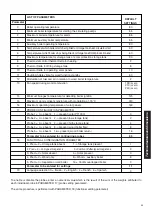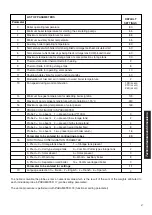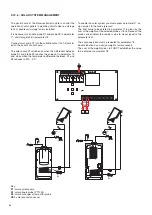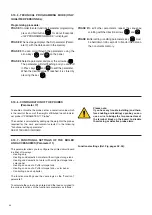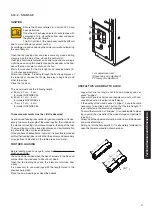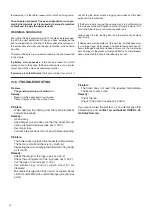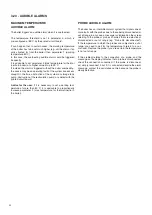
49
Tec
hnical f
eatures and dimensions
CHECKING SEALS
During the initial start-up, check the tightness of
the smoke circuit and connection to the chimney.
If there is any noticeable flue gas leak, alert the
installer and/or our After-Sales Service. If there is
any noticeable air suction through the door seals,
tighten the handle with greater force.
Make sure the working thermostat Te is in good
running order at full power until it stops the fan.
Check for leaks from plumbing connections.
After the initial start, with the boiler off, open the
lower door and inspect the internal walls and
insulation of the door: they should be of a light
colour, indicative of proper air adjustment.
Otherwise, if the walls are blackened, it means
the secondary air is not adjusted properly.
THE BYPASS
The bypass is a direct passage between the fire-
wood storage compartment and the chimney.
By opening the wood loading door, the by-pass
allows the accumulated flue gas in the storage
compartment to be extracted and conveyed directly
to the chimney.
The bypass, in conclusion, allows the smoke to be
discharged to the chimney without escaping from
the top door when loading the wood or lighting.
However, it is essential to open the top loading door
slowly and equally gradually to rotate the anti-smoke
flap to achieve effective flue gas extraction.
BYPASS INSPECTION
During the installation stage and, in any case, before
starting to use the boiler, it is necessary to check
the tightness first and then operation of the bypass.
Make sure the bypass rod works and that the mi-
cro-switch is positioned correctly. Check that the fan
starts up as soon as the door opens.
3.15.4 - CHECKS TO BE CARRIED OUT AFTER
COMMISSIONING
3.16 - SUMMER MODE
The use of the boiler in summer only for the
production of domestic hot water is not advis-
able, unless the boiler is run strictly following
these rules:
1) Use very dry wood
2) Load a small amount of wood in the boiler 2
or 3 times a day as needed.
Important.
It is very wrong to load the boiler completely,
providing it with long self-sufficiency (for example
24 hours). This way the boiler (with fan stopped)
would produce much acid condensation corrod-
ing the wood storage compartment.
3.17 - WARNINGS
HOW TO AVOID CORROSION IN THE
WOOD STORAGE COMPARTMENT
The use of wood with a high moisture content (higher than about
25%) and/or loads not proportioned to the system’s heat request
(long OFF periods with the wood storage full) can cause con-
siderable condensate formation in the storage compartment’s
internal wall.
Check the steel walls of the upper wood storage once a week.
They must be covered by a slight layer of dry tar, opaque colour-
ed, with bubbles tending to break and fall off. On the other hand,
the tar will have a glossy, runny appearance and liquid will appear
if it is removed with a poker: accordingly, it is necessary to use
wood that is less damp and/or reduce the amount of loaded wood.
If, despite these measures, the tar does not dry, it is obligatory
to report the anomaly to the After-Sales Service.
The condensate inside the firewood storage compartment
causes the steel sheets to corrode.
Corrosion is not covered by the warranty, as it is
caused by improper use of the boiler (wet wood,
excessive loading, etc.).
CORROSION OF THE FLUE CIRCUIT
Flue gas is rich in water vapour, due to combustion and the use
of wood which retains water.
If the flue gas comes into contact with relatively cold surfaces
(having a temperature below 60 - 70 °C), the water vapour
condensates and, combining with other combustion products,
originates corrosion of the metallic parts.
Check daily whether there are signs of flue gas condensation
(black liquid on the floor and behind the boiler). In this case wood
with a lower moisture content must be used; check recirculation
pump operation and the flue gas temperature at partial load, and
increase the operating temperature. In order to control the room
Содержание NOVAIREX 35
Страница 1: ...INSTALLATION AND MAINTENANCE INSTRUCTIONS NOVAIREX 35 45 55 ...
Страница 55: ......

